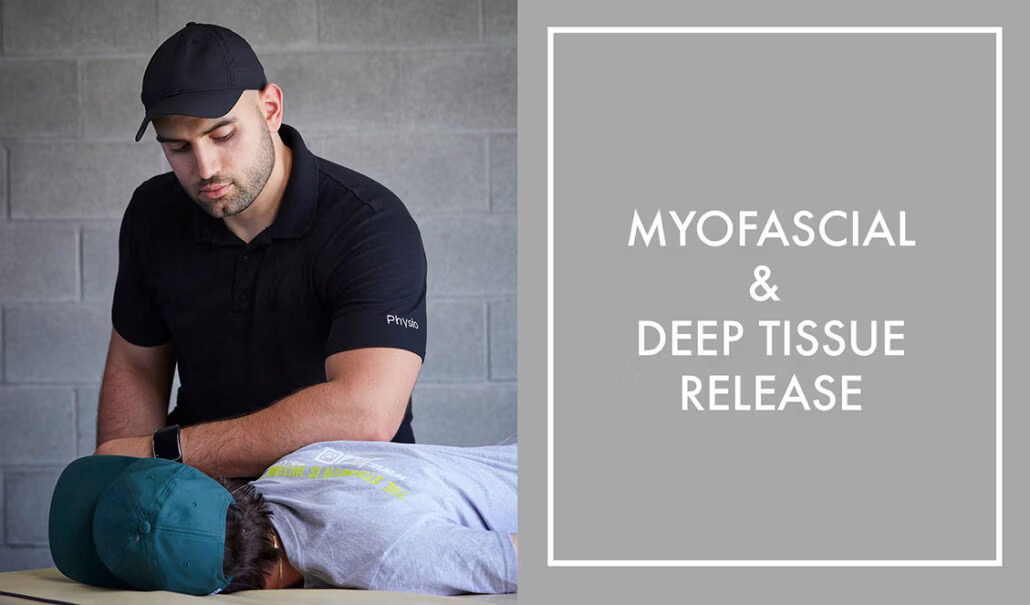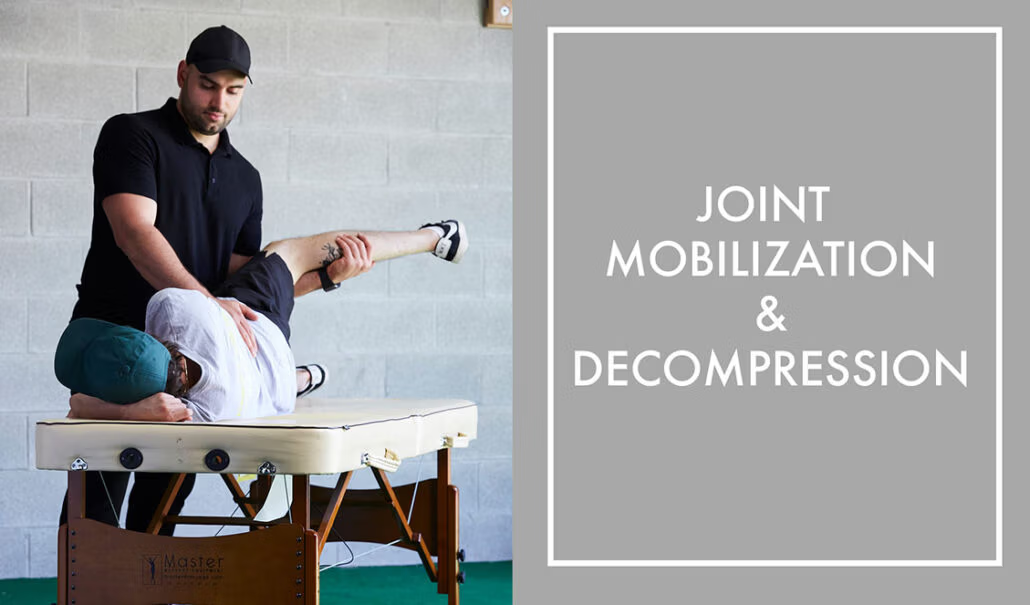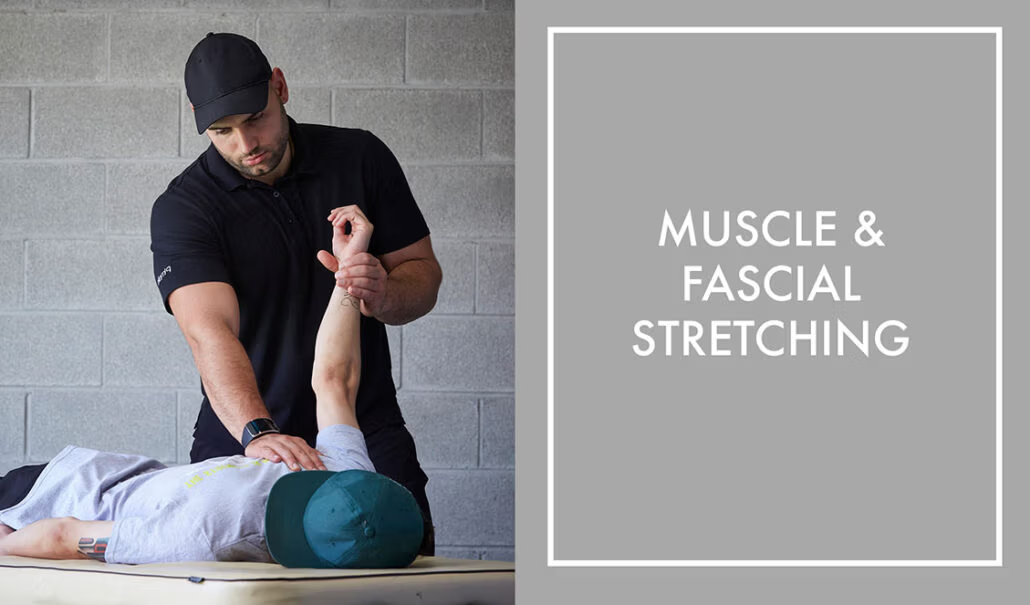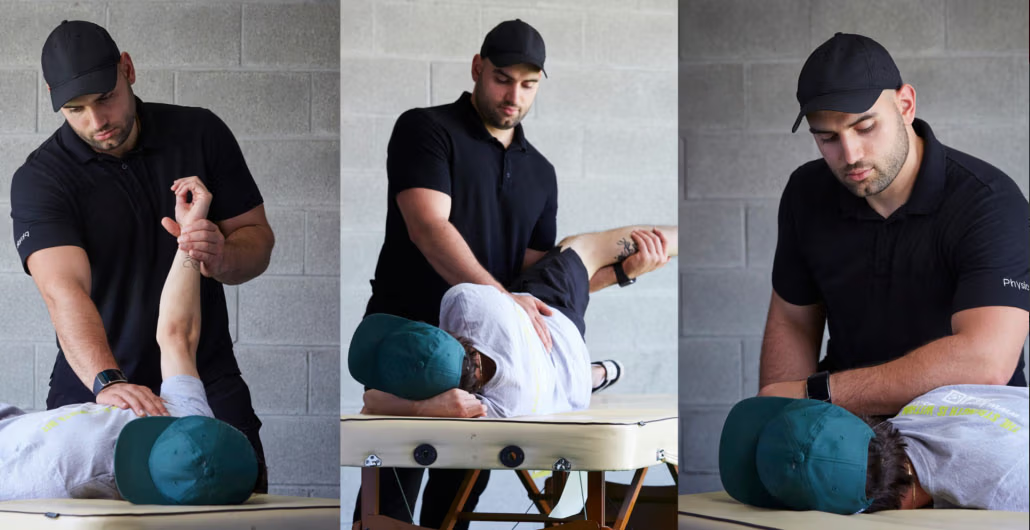What comes to your mind when you hear physiotherapy treatment? I’m always curious about this when meeting a patient who’s seeking it. I ask if they’ve ever received physio treatment before. Their answer will dictate how I explain what I’m about to do in terms of physio treatment. Most clinics tend to list the things they do but fail to really explain what they mean. And when you’re throwing around terms like “manual therapy”, you can’t really expect people to immediately know what that is.
That is why I created a list of the fundamental things we do at Boss Physio to help people become stronger, healthier versions of themselves. Each list item is followed by a thorough explanation of the “why” and “how” for each technique. Hopefully this paints a better picture of what we do as well as why we do it.

PHYSIOTHERAPY TREATMENT #1: MYOFASCIAL AND DEEP TISSUE RELEASE
Myofascial release is a foundational physiotherapy treatment technique we use. The term myofascia refers to the connective tissue called “fascia” that surrounds and connects muscle groups together. If you’ve ever had steak before, you’ve probably had some chewy pieces filled with it. I describe fascia in two ways:
- Like a saran wrap that keeps our muscles grouped together. Take your quads for example. It’s a group of 4 muscles kept organized together through fascial wrapping. Without them, you’d see these muscles jumping in different directions when they activate and contract.
- Like a train track that connects different muscle group regions together. In this example, I stress that we cannot just look at muscles as single units that work on their own. They’re a series of stations that communicate with each other to permit the complex movements we undertake as humans.
Myofascia like many other regions of the human body can get tight through poor posture, lack of exercise, and injury. Getting tight here restricts movement and provokes pain which can lead to more issues. We use myofascial release as one of the first manual therapy techniques to address this issue. It’s a hands-on treatment in which the physiotherapist applies a force against the patient’s body, and moves it slowly in directions that follow the path of myofascia.
This force is applied multiple times and is a bit painful although the therapist ensures it’s something the patient can handle. The muscles underneath the skin get looser as the force continues to be applied. Afterwards, we test how the patient moves to see if there’s an improvement. This process is repeated for multiple regions thought to influence the patient’s condition.

PHYSIOTHERAPY TREATMENT #2: JOINT MOBILIZATIONS & DECOMPRESSION
Next, we address the deeper issue of the joints themselves. Joints are areas at which two or more different bones interact to cause movements like hinging, gliding, and rotation. There are almost as many days in the year as there are joints in the body (360 of them). As a physiotherapy treatment, joint mobilizations serve to:
- Put the contact surface between the two or more bones in a more ideal position
- Free up restrictions in any part of a joint’s motion
- Get the fluid within the joint moving to help improve nutrient-flow
- Decrease pain through the activation of things called mechano-receptors
I like to use the phrase “use it or lose it” when explaining why it’s essential to mobilize a restricted joint. Joint restrictions are known to turn into negative feedback loops when left unaddressed. It looks something like this: The patient doesn’t move as much to avoid pain → which leads to restrictions → the pain occurs earlier in the movement now → which leads to more restrictions → and then eventually… well, you know where we’re headed.
The technique itself involves the physiotherapist taking a specific hold of a problematic joint and applying detailed pressures to help move and restore motion in it. This can be done as holds, oscillations, or even manipulations (often described as “cracking” the joint). The goal of this physio treatment is to free up the joint enough so the patient can move more effectively and function better.

PHYSIO TREATMENT #3: MUSCLE & FASCIAL STRETCH PHYSIOTHERAPY TREATMENT
Although stretching is interpreted as a general term, there’s quite a bit of variation in the techniques that exist. Each has its own benefits and optimal times of use. As a manual therapy technique, it can provide immediate benefits to those suffering through a great deal of muscle and fascial tightness. The three techniques we use quite often include:
- Hold Stretches – these are what people typically think of when they hear the word “stretch”. The patient is told to relax as the physical therapist puts a tight muscle into a stretch position. This is held anywhere between 30 seconds to 2 minutes at a time. The goal is to get the muscle to relax and lengthen over time and is helpful for most people dealing with really tight muscles.
- PNF Stretches – we use PNF stretches to address the more complicated forms of tightness in the muscle. The goal is to stretch the muscle while down-regulating a neurological drive that is keeping it in a “shortened” or tight position. Once a full stretch is achieved by the therapist, the patient is then asked the contract the muscle being stretch but pushing against the therapist. They’re told to do this for 5 seconds and slowly back off that pressure. Afterwards, the physio is able to put the muscle into a greater stretch. The process is repeated until no further stretch can be achieved and/or the patient cites an emergence of pain with the stretch.
- Fascial Stretches – lastly, we use fascial stretches. The body is an interconnected network of fascia units. Because of this interconnectivity, whole-body stretches are used to put this entire network of fascia in a stretch. This is different than a hold or PNF stretch that is typically targeting one muscle. Fascial stretches target a whole connected network of muscles that influence each other. These types of stretches are a bit more complex, typically done later in the rehab protocol.

PHYSIO TREATMENT #4: CORRECTIVE EXERCISES & MOVEMENT PROGRAMMING
Nothing says effective physiotherapy treatment more than those backed heavily by empirical research. Of all the techniques we use (and we use a lot of them), corrective exercise and movement programming provide the most significant results. We are moving beings so it’s not a far fetch to deduce that movement is the purest form of physio treatment we can get.
A huge goal of ours is to restore natural and healthy movement patterns in our patients. We use exercises individually tailored for each patient as our way to do it. Of course, there are many levels of exercises we have available in our toolkits. Their use depends on what part of the rehab journey our patient is currently on. If it’s early on, we might decide to use exercises designed to help reduce pain and slowly increase mobility.
If we’re in the later stages of their rehab program, we might use more complex multi-joint movements and intense strengthening regiments. These are designed to work out any remaining kinks and help injury-proof the patient going forward. Exercises are almost always given as homework for the patients, and their compliance to them only helps improve their therapeutic outcomes.
Whatever the goal may be, one thing’s for sure. In the physical therapy world – movement is not the only key, it’s the foundation on which everything else must build on. At its core, if you can’t move, nothing else should matter more. We need to fix movement as a top priority.

LIFESTYLE MANAGEMENT, POSTURE CORRECTION, & ERGONOMICS
Lastly, we use lifestyle, posture, and ergonomic corrections to fit that final piece in the puzzle. As we’re removing pain and improving motion, we must address the elements that caused problems in the first place. This can come in many forms including:
- Poor Lifestyle Choices such as a lack of movement, faulty habits, etc.
- Poor Posture such as the slump we get from prolonged sitting.
- Poor Work Environment such as repetitive work in the same position without breaks, or high-risk environments for injury.
Whatever it may be, it must either be changed or modified. This is a big education piece on our part as physiotherapists. We must inform our patients of these potential stressors and teach them ways to reduce their negative effects. Physiotherapy treatment is incomplete without this very important aspect of our care. We can do as much manual therapy and corrective exercise as we like. However, if we don’t address the cause of such issues then we’re not fully doing our jobs of optimizing our client’s health.
CONCLUSION
This is a pretty exhaustive list, although we left out methods we don’t use as often or aren’t backed by as much research. These can include things like electrotherapy and therapeutic ultrasound. So there you have it – finally, a list of what we do as well as an explanation. If you have any questions at all, feel free to shoot us a call, text, or email. And please if you found this helpful, share this with anyone else who’d benefit from this information. Hope you guys enjoyed and stay tuned for more!
Boss Physio, out.

